With hundreds of success stories behind it, this step-by-step sourdough starter recipe shows you how to create your own bubbly starter in six days, no fancy tools required. Perfected over years of testing, this easy method is foolproof!
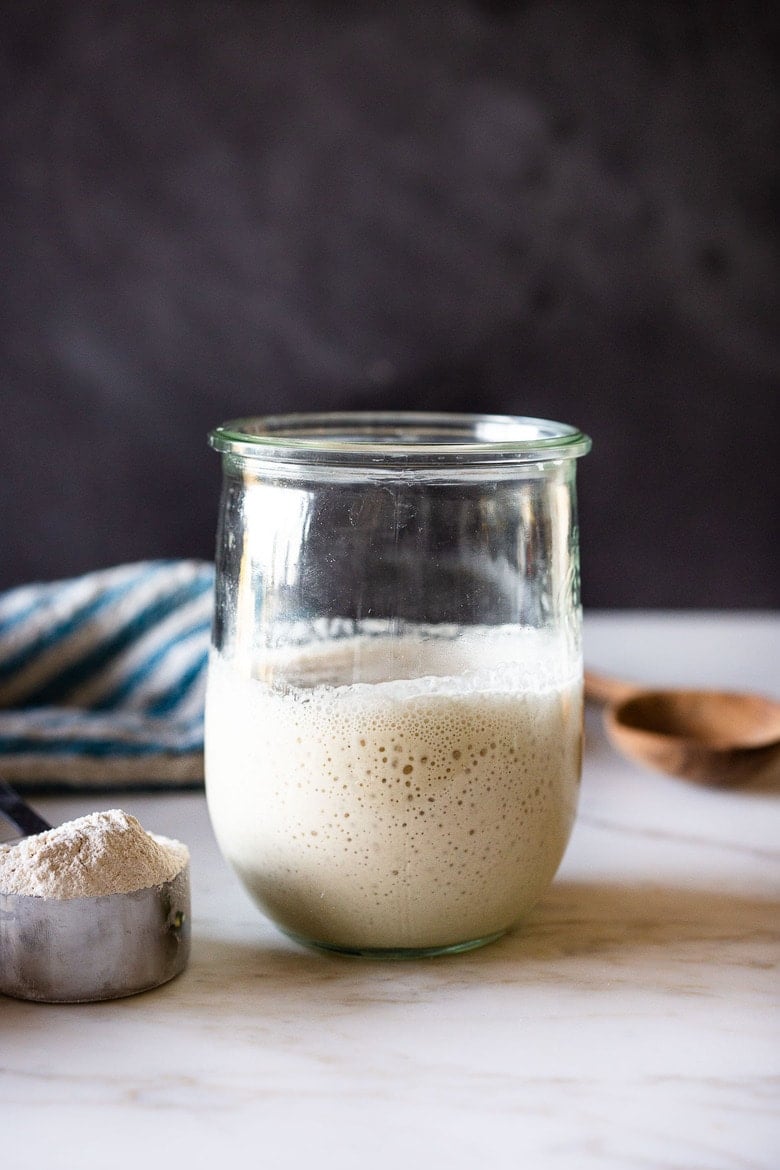
When you understand one thing through and through, you understand everything.
Shunryu Suzuki
With over 500 five-star reviews and hundreds of success stories, my chef's perfected sourdough starter guide has everything you need to make your own homemade starter. It is an easy process, and once you understand it, you’ll think to yourself, Why didn’t I do this sooner! In just six days, you'll be baking the most beautiful sourdough bread! Just read all the success stories below.
What is Sourdough starter?
Sourdough starter is a “wild yeast” made from flour, water, and the natural wild yeast in the air. With a little care and patience, it ferments, and when strong and active, just a little bit of starter replaces commercial yeast and makes your bread rise, while transforming the gluten in the bread into something more easily digestible. Store-bought yeast is not needed!
How long will it take?
It takes 6-7 days to make sourdough starter from scratch. In colder climates, it can take up to 12 days, and in warmer climates, it may only take 5 days. Once you have a bubbling active starter that consistently rises and falls, you can bake sourdough bread, typically on day 7. For a primer, watch the 20-minute Sourdough Video below, where I personally walk you through each day.
Watch: How to Make Sourdough Starter From Bread Flour
Fast forward to Specific Day by video time (using scroll bar underneath video)
- Day 1 Morning: :23
- Day 2 Morning: 4:10
- Day 3 Morning: 7:00
- Day 3 Evening: 9:12
- Day 4 Morning: 11:50
- Day 4 Evening: 13:37
- Day 5 Morning: 14:45
- Day 6 Evening: 16:50
- Day 6 Morning: 18:12
- Day 6 Evening: 20:10
Best Sourdough Starter Ingredients
Sourdough Starter Equipment
- Jar – A wide-mouth quart jar or a Weck’s 1-liter tulip jar.
- Kitchen Scale – using a kitchen scale helps measure the flour and water more accurately – optional but handy.
- Thermometer – Knowing the temperature of the starter using a thermometer gives you great information!
Sourdough Starter Ingredients
- Flour – 5 lb bag of organic bread flour (plus 1-2 cups organic whole grain flour like rye flour or whole wheat flour). All-purpose flour is not reccommended. Whole grain flour has more wild yeast- and will help jump start your starter!
- Water – filtered water, tap water, or mineral water (specifically, San Pellegrino, for the correct mineral ratio). Distilled water does not have enough minerals.
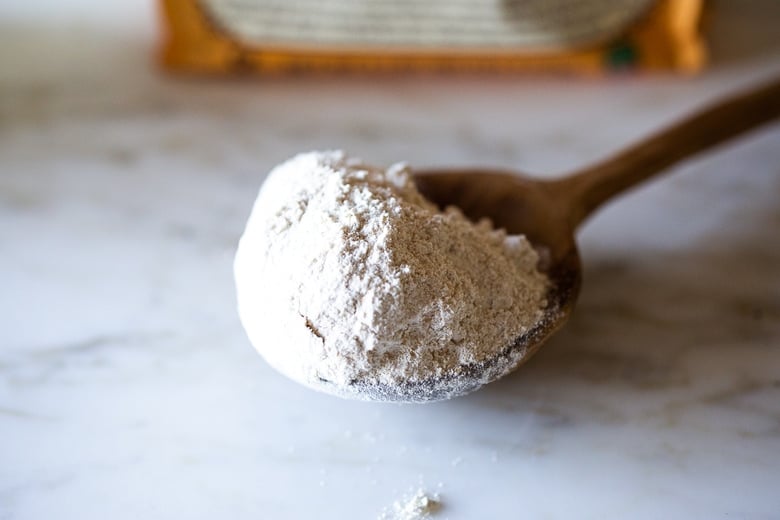
Understanding Your Sourdough Starter
The secret to making sourdough starter is understanding the process, your environment and your starter’s needs. Each starter is different and unique. Here, we’ll show you what to look for and most importantly, why.
- Think of sourdough starter as a yeast. Only in this case, instead of buying a packet of yeast from the store, you are making your own living “wild yeast” by fermenting flour and water. Once it’s bubbly and happy, it is very much like a very low-maintenance pet. Yes, you can even name it. Mine is called Vita.
- You must feed it (stir in a mixture of flour and water) once a week to keep your pet active and strong. We will show you how to tell when it is hungry and when to feed it.
- Some people believe that bread made with sourdough starter is actually better for you than bread made with yeast. Here and here are a few articles to get you started on your own research. While I’m not sure if this is scientifically proven, I do know that bread made with sourdough starter, tastes infinitely better, feels easier to digest, and has more complexity and better texture than bread made with commercial yeast. So if you are a bread lover, this is absolutely the way to go, as far as the quality of your finished bread.
How to Make Sourdough Starter from Bread Flour
*See the recipe card for detailed instructions.
For your first measurement, weigh the flour using a kitchen scale so you can get an idea of how the mixture should feel. Do not weigh the measuring cup! It should be like a thick paste, like peanut butter. If you need to add a little more water to incorporate the flour, that is OK too.
Day 1: Starting in the morning or at night, using a wide-mouth quart jar, tulip jar, mix 1 cup whole grain flour (120 grams) with 1/2 cup filtered water (120 grams) using a fork, making sure you’ve incorporated all the dry flour.
Place the lid lightly on top (using the Weck jar lid is really handy here) or a wet towel to keep moisture in, or plastic wrap- and let sit at room temperature (70-ish degrees) on the kitchen counter for 24-48 hours. If you are unsure how warm it is, use a kitchen thermometer and check it a few hours later. It is best at 70-75°F.
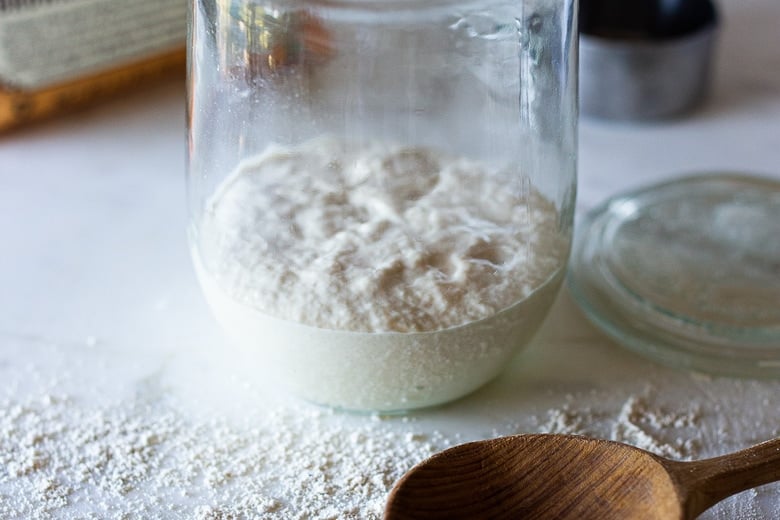
Day 2: After the first 24 hours, there may or may not be a bit of bubbling. Let the mixture rest until you see activity (bubbles or rising). Sometimes this takes 36 hours or even 48 hours, especially if the weather is very cold. When you see active bubbling, discard all but 1/2 cup of the starter (4 ounces).
To the remaining ½ cup of starter, stir in 1/2 cup lukewarm water (120 grams), and mix well with a fork. Add 1 cup of organic bread flour (120 grams) spooned and leveled. Stir until combined. Again, it should feel like a thick paste. If overly dry, feel free to add a bit more water. Cover again and allow the mixture to sit at room temperature for another 24 hours.
Day 3: After 24 hours, hopefully, you will see some bubbling or rising, and if not, let it go longer until you see some activity. Be patient. Depending on how warm your house is and how active your starter, you may need to feed it less often or more often, depending on when it gets “hungry”.
How to Know when to Feed your starter
Only feed your starter after it has peaked or looks “hungry”. Feeding it when it is “not hungry” will basically dilute all the growing yeast and make it lethargic. Better to underfeed than overfeed. How to tell if it is hungry?
- Look for “slide marks” (be sure to use a clean jar so you can see these clearly-see photo below).
- Thin and runny. The starter is liquid enough to pour out of the jar (when at room temperature).
- There is liquid at the top of the starter- a clear sign of hunger!
- Smells like acetone. The starter has processed all of the previous feeding and needs to be fed again.
In the photo below, the starter “peaked” at the top line, then slid down. I call these slide marks- indicating the starter is hungry.

This might be 12 hours, it might be 14, it might be 18, or 24, depending on the temp in your house. In very warm climates, it may only be 6-8 hours. In winter, this may take 36 hours. It is better to underfeed rather than overfeed.
For each feeding, discard all but 1/2 cup of the starter (keeping roughly ½-cup of starter in the jar). Add 1/2 cup water and 1 cup bread flour (spooned and leveled). Mix well, cover, and let this rest at room temperature for 12-24 hours or until the starter looks “hungry” again before repeating.
Day 4: Feed 1-2 times a day (only feeding when hungry), discarding all but 1/2 cup of starter each time. Feed 1 cup of bread flour and 1/2 cup of water.
TIP: It is typical on day 4 for the starter to slow down and stall a bit. This is OK. Just keep going, be patient, and look for the hunger signs, and only feed when clearly hungry. Hopefully, you’ll begin to see some rising and falling. It’s helpful to put the starter in a clean jar each day and mark the beginning level (with a sharpie, string or rubber band) so you can easily see this.
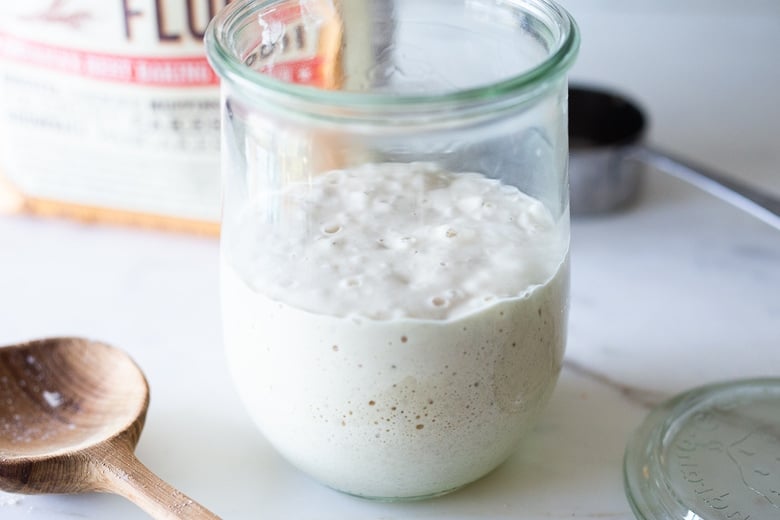
Above, you’ll see it peaking, and below, you’ll see it deflating and getting “hungry.” There may not be too much difference in the beginning, so look closely.
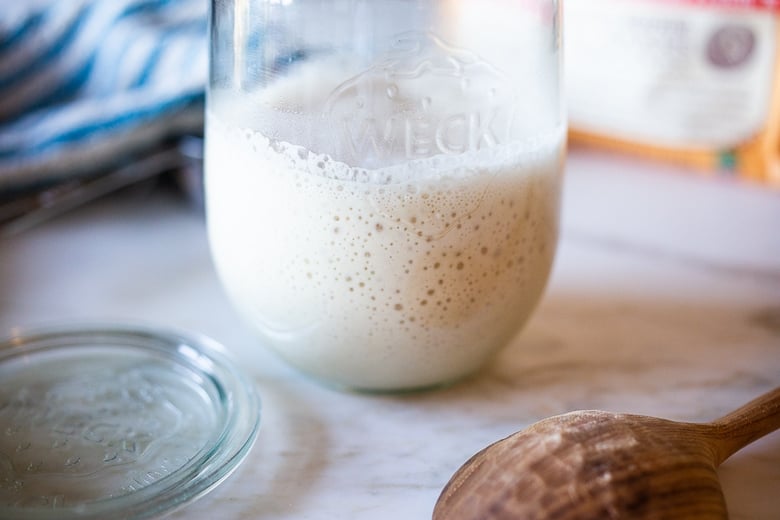
Understand that your starter has a schedule of its own; it is a living thing, so watch it and pay attention.
If your starter is not rising and falling, look at its consistency. As it metabolizes the flour and gets hungry, it will get runny and liquidy, like to the point where you can pour it right out of the jar. If it is still thick like paste, it’s not done metabolizing (eating) the flour.
Day 5: Feed again, 1-2 times, discarding all but a 1/2 cup of the starter each time. Add 1 cup of bread flour and 1/2 cup of lukewarm water. The starter should look visibly active, bubbling, rising, hopefully, close to doubling in size.
*Repeat day 5 until the starter is rising and falling predictably and is close to doubling in size within 6-8 hours.
If your starter is not rising but there is evidence of hunger (runny or liquid at the top), try these three things:
- Substitute 1/4 cup whole grain flour (add to ¾ cup white bread flour) on your next feeding.
- Use mineral water like San Pellegrino instead of water.
- Stir the starter a few times after feeding to allow more wild yeast from the kitchen to get inside.
DAY 6 Morning: Baking day! Give it one last feeding in the morning: this time discard all but a 1/3 cup. (The reason we are changing this to 1/3 cup is to feed it a little bit more.) Add 1 cup flour (120 grams) and 1/2 cup water, stir, and place it in a clean jar so you can see the activity clearly. You can use a Sharpie or place a rubber band around the jar to mark the beginning level.
How to Know When Your Bread Flour Sourdough Starter is Ready to Bake Bread
The starter should double in volume within 6-8 hours of feeding.
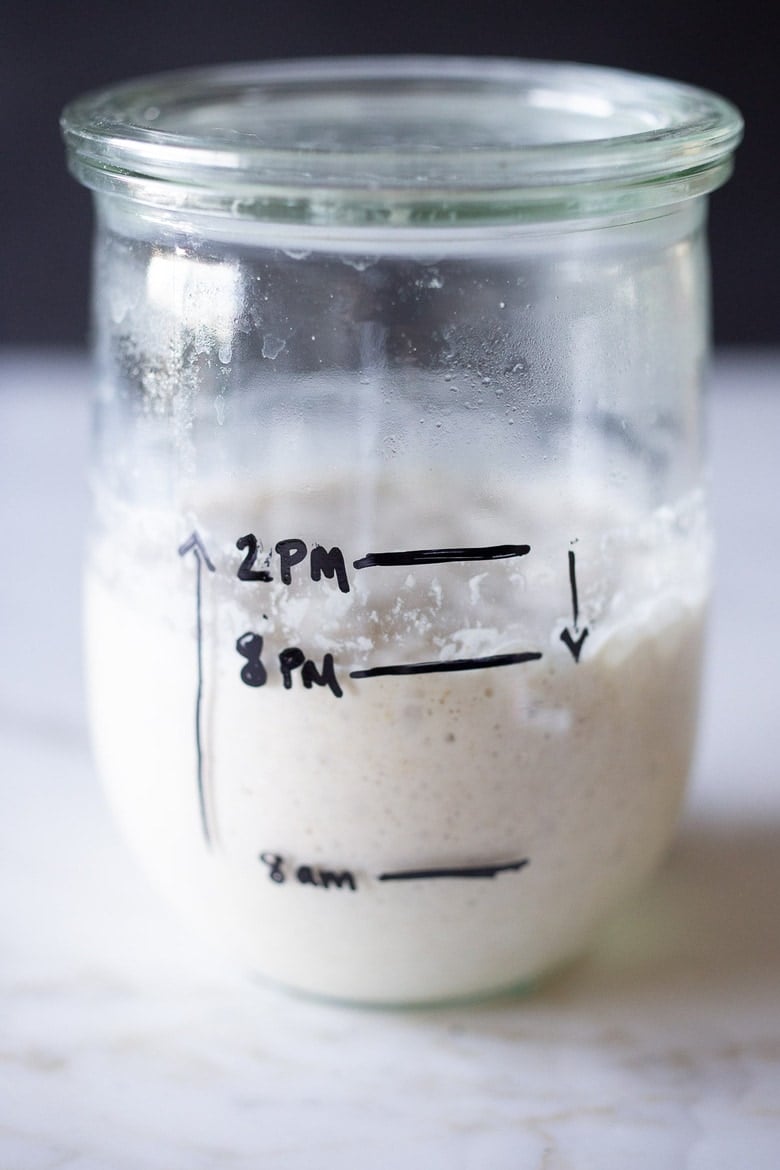
In the photo above, on the 6th day, the starter was fed at 8 am, it peaked around 2 pm, then it started deflating, and by 8 pm, it was “hungry” again. See those downward “slide” marks on the jar?
Do the Float Test
When the starter is at its peak, or just after, place a teaspoon of starter (just from the top, don’t stir it down) in a glass full of water; it should hopefully float. If it floats, success! Congrats. You can now make our sourdough bread…tonight!
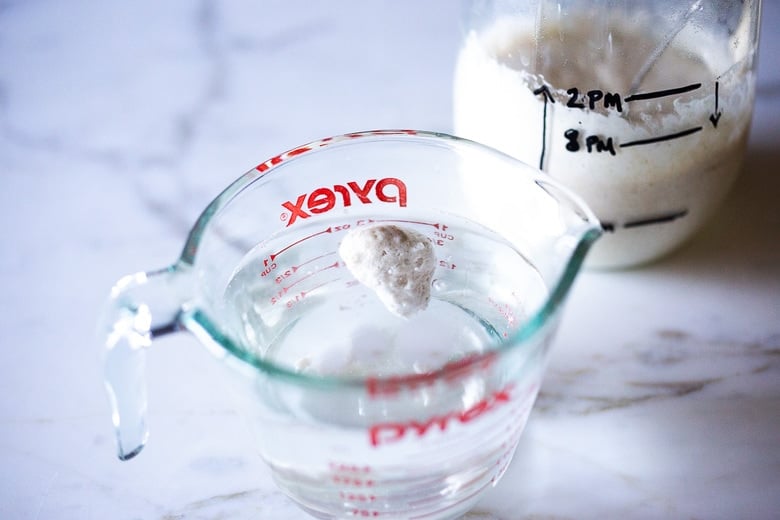
My Best Sourdough Baking Tip. When baking bread, always use a hungry starter that has already peaked.
STARTER DOES NOT FLOAT? If it doubles in size but does not float, you can still try baking a loaf if it doubles within 6-8 hours of feeding it.
At this point, if your starter does not double in size within 6-8 hours of feeding, don’t give up! Often, it just takes longer, especially during the winter months. Continue feeding one to two times a day until you see a consistent, predictable rise and fall.
Read the troubleshooting section. If you need to take a break, put it in the fridge and try it again up to a week later. Don’t toss it!
Day 6 Evening: Let’s Bake! Use 1/3 cup starter to make this sourdough bread recipe and place the remaining starter (or if not making bread, place all of it) in the refrigerator, and feed it at least once a week, reserving ½ cup starter, before feeding it the usual 1 cup bread flour, 1/2 cup water.
TROUBLESHOOTING the Best Sourdough Starter
- SMELL: Starter should smell sweet, tangy, earthy, like a wet horse – not “bad”. If it really smells foul or unpleasant, you may have used an unclean jar, an unclean utensil, or somehow introduced other bad bacteria. I would start over.
- NO ACTION: On day 4-5 it is typically for it to slow down. If your starter is not rising at all but there is evidence of hunger (liquid at the top, or bubbles) try 3 things. First substitute 1/4 cup whole grain flour (add to ¾ cup white bread flour) on your next feeding. If no rise, then try using mineral water, specifically San Pellegrino instead of water. San Pelligrino specifically has the right mineral ratio, I have great luck with it. Others not so much! Also try stirring the starter a couple of hours after feeding, a couple of times throughout the day to allow wild yeast from the room to get in there. Lastly, you could try pineapple juice instead of water.
- FLOUR: Try to use fresh milled whole grain flour to start, then organic BREAD FLOUR. The more wild yeast in the flour, the better your starter will do, so smaller brands like Bob’s Red Mill seem to do better than bigger conventional brands that have been overly processed. It is totally OK to mix flours and to switch them up- this adds different kinds of wild yeast- a good thing!
- DO NOT overfeed. For example, maybe feeding 2 x day at 12-hour intervals is too often. You want to feed after the starter has peaked, then deflated (see photo above- you’ll see some slide marks on the jar) and this tells you that it is hungry. If you feed the starter before it has had a chance to metabolize (or eat) all the flour (before peaking) and then you discard part of it, and feed it again, you are actually diluting all that amazing bacteria, weakening your starter. So it’s all about watching your starter in your home. If you are not seeing rising and falling, but notice the starter just gets liquidy, this too is a sign of “hunger”. Or if it gets runny enough to pour out of the jar, another sign it is hungry. There are lots of variables here. Just be patient, pay attention and watch. This is a living thing- it doesn’t care about time schedules and recipes or what it “should” do. It will “eat” when it is “hungry” and sometimes it likes to eat slowly. 😉
- TIME: It may take longer than 6 days in colder environments. Use a kitchen thermometer and take its temp. Is it over 65F? Find a place where it can be warm. In the oven with the light on, or in an upper cupboard (heat rises). Sometimes it takes 12-14 days! Be patient, keep going. If it is doing absolutely nothing, leave it out on the counter for 24-48 hours and see what happens. If you run out of flour or need a break, don’t just toss it; put it in the fridge and see if you can get it going a few days later.
- ACIDITY: If you still can’t get that starter going, some people recommend subbing pineapple juice for the water for one feeding- raising the acidity level. My good friend just tried this and it got hers going.
- LIQUID: If you see any liquid at the top of your starter, it means your starter is hungry. So, yes it’s still alive which is a good thing! You can stir the liquid in, or pour the liquid out, either way, but feed it. This is a sign that you may need to feed it more often.
- MOLD: if you see any discoloring or mold on the surface, starter was probably contaminated. If it is only on the surface, it is probably ok to save. Scrape it off, save 1/2 cup of the underneath starter, and keep going, using a clean jar. Feed, smell, use your best judgment.
- FLOAT TEST: Try testing when your starter is peaking. Take a spoonful from the top without stirring it down. If your starter is rising and falling consistently, but not passing the float test and it has been over 8-10 days, just try baking a loaf. People are having luck with good loaves without passing the float test. It may be the flour…

Sourdough Starter with Bread Flour Storage Tips
- REFRIGERATE & FEED AT LEAST ONCE A WEEK: Pick a scheduled day and try to stick with it, always reserving 1/2 cup and feeding it 1 cup flour and 1/2 cup water. Discard the remaining, give it away, or keep the discard in a separate container for sourdough pancakes, sourdough buns, banana bread, biscuits, etc. I usually don’t feed the discard unless I give it away.
- If you forget to feed it one week, it is most likely OK; feed it 1-2 times a day for 1-3 days in a row to revive it (keeping it out on the counter) until bubbly and active and doubles within 6 hours. I’ve left my starter for a month on vacation (in the fridge) without feeding and simply revived it by feeding it 3 days in a row, 1-2 x day. It’s surprisingly hard to kill. You can also freeze it for more extended storage.
- This batch of starter will allow you to bake 2 loaves of bread per week with enough left to feed for the next week. If you want to bake more often, you can keep it out and feed it 1-2 x daily. Or if baking every few days, you can pull it out of the fridge, feed it 10 hours before using, leaving it out, use what you need while it is peaking (or slightly after), then put it back in the fridge that evening. Do the same thing a few days later when ready to use again. So this would be feeding 2-3 times a week, best if baking 4-5 times a week.
- If you are not actively baking, you can maintain a smaller amount of starter using the same ratios.
- You can also freeze the sourdough starter if you’re leaving on a long trip.
FAQs for this Sourdough Starter Recipe with Bread Flour
Yes. While you are building your starter, during the first week, it is the simplest, easiest, fastest, and most economical way to create a healthy starter. (Or save it separately -in the fridge- and use it in Pancakes, Waffles, Buns, or Biscuits. ) This is because you always have to feed it two times its volume in flour. For example-if you kept all the 1 1/2 cups of starter, you would have to feed it 3 cups of flour (instead of keeping just a 1/2 cup and only feeding it ONE cup). Discarding will shorten the fermentation process, require less flour in the long run, and create a stronger starter. Once your starter is “established” after the first week- then you can give it away to friends or use it in pizza dough, pancakes, etc).
This recipe for Sourdough Starter takes 6 days (or up to 12 days if it is very cold where you live).
The only ingredients you need to get started are flour (bread flour and whole grain flour) and water.
What is the biggest mistake you can make with your sourdough starter?
The most common mistake is overfeeding, which weakens your starter instead of making it stronger. The secret is to watch for signs of hunger-bubbles slowing down, slide marks in the jar, or liquid on top-before feeding. Once you learn to read your starter's natural rhythm, it will stay bubbly, active, and ready to bake with.
It's surprisingly simple to make a sourdough starter! The process is hands-off and only takes a few minutes each day. The key is consistency: feed it regularly and keep it at a steady temperature. Once you get into the rhythm, caring for your starter becomes second nature, and you'll be rewarded with a healthy, bubbly culture for all your baking.
How to use Beginner Sourdough Starter
- See all our Sourdough Recipes!
- Sourdough Scones
- Sourdough Crackers
- Sourdough Biscuits
- Sourdough English Muffins
- Sourdough Tortillas!
- Vegan Banana Bread
- Overnight Sourdough Waffles
More from Feasting At Home

Sourdough Starter Recipe with Bread Flour
- Prep Time: 30
- Cook Time: 6 days
- Total Time: 144 hours 30 minutes
- Yield: 1 ½ cups 1x
- Category: sourdough, fermented, cultured, bread, baking,
- Method: fermented
- Cuisine: bread
- Diet: Vegan
Description
How to make your own Sourdough Starter (see the step-by-step video in post) using simple ingredients with no special equipment, in 6 days, that can be used in sourdough bread. Sourdough Starter is a wild yeast, made from fermenting flour and water.
Ingredients
- 120 grams whole grain flour (whole wheat flour, rye flour, or freshly milled flour) 1 cup, fluffed, spooned and leveled
- Organic White Bread Flour (5-10 lb bag ) I like Shepherd’s Grain or Bob’s Red Mill.
- 120 grams Water per feeding (1/2 cup water)
Instructions
-
- Day 1: Starting in the morning or at night, using a wide-mouth quart jar or Crock or Glass Measuring Cup mix 1 cup whole grain flour (120 grams) with 1/2 cup (120 grams) filtered water using a fork making sure you’ve incorporated all the dry flour. For your first measuring – it is a good idea to weigh the flour, using a kitchen scale so you get an idea of how thick it should feel. It should be like a thick paste. Thick like peanut butter. If you need to add a little more water to incorporate the flour, that is OK, but be precise with the flour. Place the lid on top (using the Weck jar is really handy here) or a damp towel to keep moisture in, or plastic wrap- and let sit at room temperature (70-80 degrees) on the kitchen counter for 24-48 hours, or until you see some bubbling. If you are not sure how warm it is, use a kitchen thermometer and check it a few hours later. See notes for TEMPERATURE.
- Day 2: After the first 24 hours, you may or may not see a bit of bubbling. I prefer to let this rest until I see a tiny bit of activity (bubbles) and sometimes this takes 36 or up to 48 hours. So start “day 2”, when you see a little bit of bubbing. Discard all but 1/2 cup (136 grams) of the starter. (See notes for discard). Add to the remainder, 1 cup of white bread flour, (120 grams), spooned and leveled, and 1/2 cup filtered water (120 grams), mixing well with a fork. Place the lid on loosely again and allow the mixture to sit at room temperature (70-80F) for another 24 hours.
- Day 3: By the third day, you should definitely see some bubbling- and if not, let it go a bit longer. Depending on how warm your house is and how active your starter, you may need to begin feeding more often, or even move to two feedings a day roughly 12 hours apart, like in the morning and at night. In a nutshell, you want to feed the starter only after it has peaked (metabolized all the flour from the last feeding) and has started sinking down or gets liquidy- this is when it is hungry! This might be 12 hours, it might be 14, it might be 18, or 24, depending on the temp in your house. In very warm climates it may only be 8 hours. It is better to underfeed rather than overfeed here. For each feeding, like before, discard all but 1/2 cup of the STARTER (keeping roughly ½-cup of starter in the jar -4 ounces or 136 grams) Add 1 cup Bread Flour (spooned and leveled) and 1/2 cup water to the 1/2 cup starter and let this rest at room temperature for 12-24 hours or until the starter looks “hungry” again before repeating.
- Day 4: Feed 1-2 times, discarding all but 1/2 cup of starter EACH TIME. Feed 1 cup bread flour, 1/2 cup water. Look for the hunger signs. Hopefully, you’ll begin to see some rising and falling. It’s helpful to put the starter in a clean jar and mark the beginning level (with sharpie, string or rubber band) so you can easily see this. ***If for some reason your starter looks like it is still rising at the time of second feeding (at night) and there is no evidence it has fallen or no slide marks, it is still “eating” so skip this feeding and feed first thing in the morning. AGAIN, Feeding it when it is “not hungry” will basically dilute all the growing yeast and make it lethargic. Better to starve than overfeed.
- Day 5: Feed again, 1-2 times, roughly 12 hours apart, or when hungry, discarding all but a 1/2 cup the starter EACH TIME. 1 cup bread flour, 1/2 cup lukewarm water. The starter should look active, bubbling, rising, sliding down, hopefully, close to doubling in size. (If not, repeat this day until starter doubles in size within 8-12 hours of feeding- and read the troubleshooting section.)
- DAY 6: Give it one last feeding. Discard all but a 1/3 cup. Add 1 cup flour ( 120 grams) and 1/2 cup water, and place it in a clean jar so you can see the action clearly. You can use a sharpie or place a rubber band around the jar to mark the beginning level. The starter should hopefully double in volume within 6 hours of feeding. When it peaks, DO THE FLOAT TEST: To test the starter, place a teaspoon of starter (just from the top, while it is peaking, don’t stir it down) in a glass full of water, it should hopefully float. If it does, you can make sourdough bread. Tonight! Let the starter keep resting at room temperature or a few more hours allowing it to fully metabolize the flour, perhaps sinking a little before making your dough. You want to make dough with slightly hungry starter. Place the remaining starter in the fridge and feed it in a week. You’ll have enough stater to make one more sourdough loaf during the week, and still have enough to feed. If you want to wait to make bread until later in the week place starter in the fridge. Be sure to feed it in 7 days. Read maintenance section.
- At this point, if your starter does not double in size don’t give up! Often it just takes longer, sometimes up to two weeks, especially if it’s cold. Continue feeding one-two times a day (only when hungry) for a few more days, until you see a visible rise and fall. Read the troubleshooting section. If you need to take a break, just put it in the fridge and try it again up to a week later. Don’t toss it- if there are bubbles, it is still alive.
- This batch of starter will make two loaves of bread with enough left over to feed for the following week.
Notes
- TEMPERATURE: The colder your home, the longer it will take for the starter to grow and become active (bubbles). Find a warm spot (70-80 degrees) for the best results. On the stovetop, with the light turned on, or on top of the fridge. Or in the oven with the light on. On top of a heating pad (set to low) with a towel in between). You can still make the starter in a colder home, it will just take longer- even up to 2 weeks.
- FLOUR: Always try to start the batch by using organic, freshly milled whole-grain flour (wheat or rye) because it has more wild yeast in it than All-Purpose or white flour and will get it active and growing sooner. You can, of course, continue to use whole grain, but I’ve had the best luck using organic “bread” flour for days 2 through 6. People have made a sourdough starter with All-Purpose flour- but personally, this has never worked for me– there are fewer nutrients and wild yeasts in the flour and results in a very lethargic starter. If it is your only option, try mixing in 2+ tablespoons of whole-grain (wheat or rye) with the AP flour per feeding. Feel free to use different flours or mix different flours together. It is OK to use all-purpose flour if in a pinch, but using it repeatedly will result in sad starter.
- WATER: I usually use tap water -but sometimes the chlorine in tap water can inhibit the growth of your starter. Lukewarm water helps fermentation to start faster. Sterilized bottled water is often overly sterile, and can also inhibit. Mineral water, like Perrier (carbonated is OK) can sometimes work miracles.
- HYDRATION: Hydration refers to the ratio of water to flour in terms of weight. It is a ratio. The starter is typically at 100% hydration- meaning equal parts flour and water, in terms of weight. So if you use 120 grams of water, use 120 grams of flour. This roughly translates to 1 cup of flour and 1/2 cup water. Feel free to weigh instead of measure if you want to be more precise, or want to familiarize yourself with the consistency you are aiming for. If using whole grain flours (which tend to be “thirstier”) and your starter seems very thick, it is totally OK to add more water to thin it a bit. I intentionally keep the hydration a little lower here (a thicker starter) so you can more clearly see the rise and fall “action” in the jar.
- STORING AND FEEDING: When your starter is kept cold, in the fridge, you don’t need to feed it as often- only once a week. Feel free to feed it “cold”, and put it right back in the fridge if you like. If you keep it out on the counter, you’ll likely need to feed it 1-2 x daily (or just watch and feed only when hungry). Cold slows down the fermentation, heat speeds it up.
- USING: When you need to use your starter for baking bread, feed it 10-12 hours before making bread dough, using it after its peak height. For a more “sour” flavored bread, use the starter straight from the fridge, 3-6 days after feeding. The starter gets more sour tasting the longer it goes without feeding. Feeding the starter the same day as making bread will produce a milder sourdough flavor.
Nutrition
- Serving Size: 1 tablespoon
- Calories: 31
- Sugar: 0 g
- Sodium: 0.2 mg
- Fat: 0.1 g
- Saturated Fat: 0 g
- Trans Fat:
- Carbohydrates: 6.2 g
- Fiber: 0.2 g
- Protein: 1 g
- Cholesterol: 0 mg
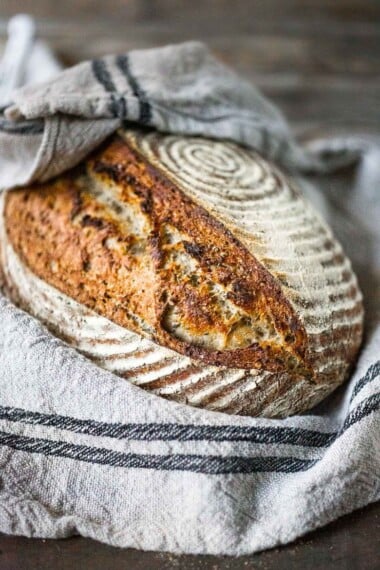

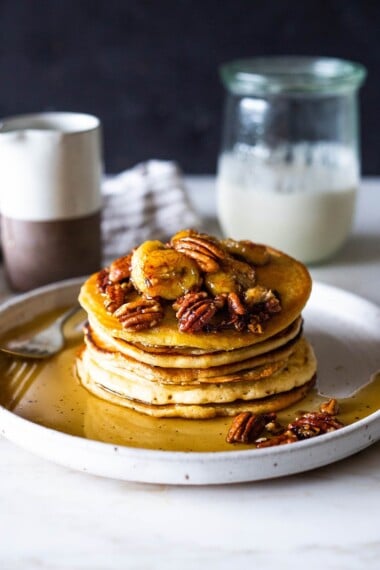
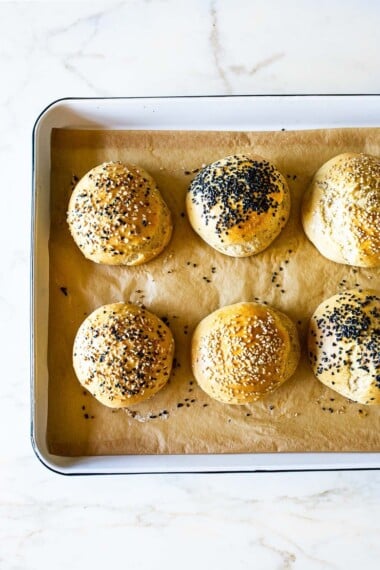





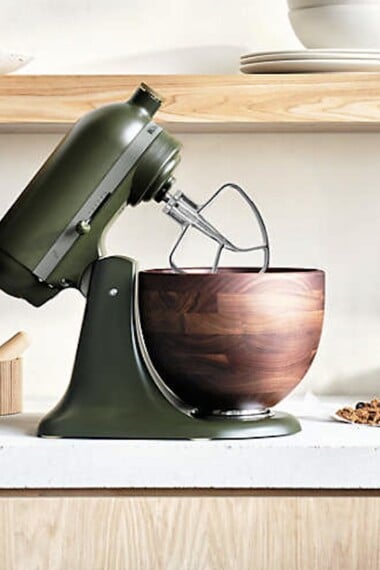


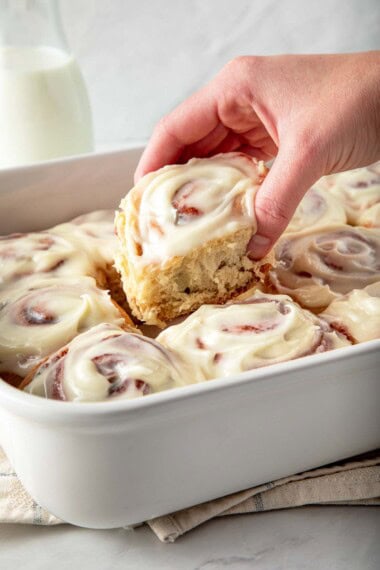

I finally passed the float test! I’ve reserved 1/2 cup to make bread. Should I feed the remainder before I refrigerate it?
yes, feed it if you only kept a 1/2 cup.
The only flour I could find locally was King Arthur unbleached, all-purpose flour. Would that work?
Not well- but people do use it. I’ve personally not had good luck with it. but you could try?
Hi Sylvia, thank you so much for the excellent instructions! I’ve tried sourdough starters before, and always given up in frustration, but this time I’m determined to get it right!
I have a question though…I started my starter 3 days ago, using whole wheat flour (and always using filtered water) and it took off like a rocket. It doubled in size in the first 12 hours (I live in a warm climate), so I figured I’d best go ahead and feed it. I switched to white all purpose flour, because you can’t get bread flour where I live (Costa Rica). The next day, it rose only very slightly over 24 hours and there were no slide marks (which made me think it wasn’t ready to be fed), but there was a layer of liquid on the top (which the instructions say means it’s hungry). I went ahead and fed it. Now, 12 hours later, the same thing is happening…very little expansion, but liquid on the top, so I’m not sure if it’s hungry or not. Any advice welcome!
Liquid means it is hungry. I would mix some whole wheat with the AP white. Or use all whole wheat. The AP white flour lacks real nutrients.
I am so grateful to your for your wonderful recipes! I made starter and it took a few extra days because I keep my house slightly cool and I think I was paying more attention to the schedule than to watching for when it became hungry. Once I started doing that and adding a tsp of whole wheat flour a time or two, we were off to the races and nearly growing out of the jar! I have now made 3 loaves and each one is better than the last. Thank you so much. So fun and I just find the loaves so very beautiful!
AWESOME AMY!
7 days to make it. Easy instructions to follow, no issues and I’m ready to make bread. The only problem is I can not get any flour in the shops so ‘Boris’now lives in the refrigerator. Thanks.
I’m anxious to try your recipe and have whole grain flour to start. I don’t think I have enough bread flour to feed the starter for the subsequent 5 days. As you know, bread flour is a scarce commodity and I can’t find it in the stores. Is there a good substitute?
You could always use more whole grain flour ( or mix it with AP flour).
I’m ready to start the recipe for the starter but am low on bread flour. It’s a scarce commodity in the stores right now. Is there a good substitute?
Try a mix of wheat and AP flour?
I am on day 6 of my starter. I have fed it once a day rather than what you recommended, twice a day, because there was little rise in the starter itself. Rather than throwing it out and starting again how can I get mine to begin rising to the extent that your one does? I have only used normal white flour from the beginning up until this point. With regards what I keep and throw out I follow your recommendations.
It sounds like it needs nutrients. Any other whole grain flour you could add to it?
Currently at a shortage of wholegrain flour but hopping to get some over the next few days. Is wholegrain good enough or is there something else you may recommend? Thanks for replying 🙂
Just anything like wholewheat or rye. Organic is ideal. Fresh milled even better. 🙂
My starter has overall been doing great over the past few days. However, I’m at the morning of day 5 after having skipped last night’s feeding, and it still doesn’t seem to be going down. Do I skip another feeding? At the beginning of my process, it seemed like I couldn’t feed it enough! I’m using all-whole wheat
Yes just wait and watch. Give it time. Tip the jar to see if it is liquidy or if it would pour out. if liquidy or sinking, time to feed. It might be colder there now?
I’m in sunny California, so the internal temperature has been an ideal 75ish degrees. It boomed on day 2 (nearly tripled in size, I posted it on Instagram if you might have seen it!)
Sylvia I have an additional question: the starter was rising and falling consistently, and then I believe I overfed it a day or two. I’ve backed off to 1 feeding about every 24 hours. Since last feeding, it’s dropped level very slightly, but it looks like there’s only the slightest amount of action – way less than I was seeing on the 2nd and 3rd days. I don’t want to go TOO long between feedings, but now I’m not sure if I’m overfeeding it and should feed it even less (is once every 36-48 hours too little?) or if the very slight drop is enough to warrant more whole-wheat flour. Temperature in the house is mid-70s, and it’s definitely getting plenty of nutrients with the all-WW flour. Doesn’t seem to be liquidy.
Wow! Thanks for doing the legwork and making this easy to follow. Obviously every environment is different but our starter seemed to expand like crazy when fed and seemed satiated for >12 hours. We actually kept feeding and discarding for almost 2 weeks until we got around to using. I could never find any bread flour at the store because you know #covid but starting with whole wheat then using white flour seemed to work for us. We are using the bread recipe right now and the dough is in the fridge waiting to be put into the Dutch oven. Thank you for this recipe and this fun exercise for us to do during quarantine 🙂 one question- can you use this in a breadmaker?
I don’t know? I’ve never used a bread maker!
Thanks for the recipe! Surprised to see that the recommendation is 1 cup flour and 1/2 cup water for the feedings after day 2. That seems like a lot of flour and not a lot of water! Should I expect the starter to be very dry?
You can add more water if you prefer (especially if using whole grain flours) but keep flour the same. I keep it thick intentionally so you can see bubble action more clearly.
Hi! thanks for showing us how to do this, I’ve found it really helpful! I have a question… When the week is over and the starter is in the fridge, when you “feed it” do you need to discard the starter (except for the half cup) as done during the first week?
Yes, always discard (or save it separately for another use). Feed only 1/2 cup starter.
It is not necessary to keep throwing away 1/2 of your starter. That is a total waste of flour. you can use less flour each time, which prevents wasting the flour. You can also save half of the mixture if you want to follow this author’s recipe and create more starter. I have been making starter for years and I have never thrown away 1/2 of what I made to keep the starter going.
Hi Sylvia,
Thank you for sharing this amazing recipe! For the first time, I made my starter and my sourdough bread with incredible success 🙂 I gonna start my second bread!
I just have one question: Do I have to make the float test every time before making a bread?
Thank you again ❤️
Maybe for the first couple times? 😉
Got it! I’ve just made second bread and it is awesome! Thank you so much 🙂
Wondering if the started is supposed to be really thick? The first day It was thick, I discarded the amount stated, added 1 cup flour 1/2 cup water and it is thick, like dough. Is this normal?
It should loosen up as it “digests” the flour. If it doesn’t just add a little more water- keeping flour the same. It might be the flour you are using is a little more thirsty.
This is great! Thank you. I had a hard time with my starter, especially keeping it warm. I don’t keep my home very warm. So I used a heating pad and placed it in near my boiler. That helped, but it wasn’t consistent. It finally dawned on me – my sous vide machine! I just put my starter, in the mason jar, in a bath of water with the sous vide set to 77! Thought I’d share for those of us in cooler climates. Thanks again!
Brillant!!!!
I have a couple questions!
First, am I supposed to screw the lid on, or just place it on top?
And second, do I wash out the jar / get a new jar, or just put the 1/2 cup of “keeper” back in the same jar?
Place it on top. Not screwed. Either wash out the jar or put it into a different clean jar. This just allows you to see the bubble action more clearly. Not necessary for Maintenence.
I am going to follow your recipe as closely as I can. I just had a starter die..it actually molded, so there are several factors I feel that caused it. However, I have one question that might help me for round 2; when feeding your starter, did you put it into a new jar each time? I feel with the mixing in the one jar and just adding feed to it might have caused any starter that was scraped high on the sides to create bad bacteria and mold.
I like to use a clean jar so I can clearly see the action. After the starter is established and kept in the fridge, I often just use the same one. 🙂
What size Dutch oven would you recommend? There are so many brands and sizes. I would like to use it for cooking as well as baking. I would like a high-quality Dutch oven.
How many people in your family do you cook for? I like Staub. 5 quart.
I’ve been looking at Le Crueset, 7 1/2 quarts. I think I read that there should be at least one inch space between the dough and the side of the pan. Is this too much? Would the 5 1/2 quart be enough? We are a family of three and I like to make stews and soups, so a Dutch oven will be useful. I just don’t want the bread to spread outward instead of up.
Right, I use a 5 quart.
Hi, yesterday (Day 4) my starter doubled in size so I did not give it a second feeding. This morning (Day 5) it got so big that it broke through the mason jar lid and leaked on the counter. I discarded all but 1/2 cup and fed it again, per the instructions. It’s been about 4 hours now and it is already doubling in size. Does this mean I can already do the float test? Or what should I do?
Yes, it is day 6 today?
It is day 5. I fed it this morning at 7am and by 2pm it burst out of the mason jar lid again. I opened it and looses the lid, but now what? I tried to float 1 tsp in a cup of water and it sunk to the bottom.
Let it sink down, feed it again, when it looks hungry. Try the float test on day 6.
I just decided to make your no knead bread recipe with it and it turned out great! Thanks!
This was a super simple recipe to follow and after 10 days I finally have a starter that is ready to be used! It took that long due to #1 me misreading the recipe and adding 1/2 cup of water to 1 cup of starter with 1 cup of flour (dang!) and #2 it being really cold in New York. On day’s 8-10 I left the starter in the oven with the oven light on and that did the trick. Thank you also for the super useful video!
Congrats!!!
My question is, why did you let the starter rest for 8 hours at room temperature after it peaks? Wouldn’t it lose its rising power by doing so? I have heard to use it right at or just after peak. Can you explain why the need to rest it? Thanks!
Not after it peaks, after feeding. Did I miswrite that somewhere?
Ah, I misunderstood! I read this: “The starter should hopefully double in volume within 4-6 hours of feeding. Let the starter rest at room temperature for 8 hours…” to mean that after it doubles, it has to rest at room temp for 8 hours, and that confused me. Now I get it. BUT, if I feed it around 8-9 a.m., and then it doubles around 1 p.m. or so, then it’s still many more hours before I would be using it–wouldn’t it become way less active and thus less suited to start baking with if I wait that long? I think right now all the timing issues are throwing me for a loop!
I see how that is confusing- I will change the wording!!!
When I’m storing the starter in the fridge and feeding weekly, is it ready to bake immediately or do I need to start the 6 day process over again?
It is ready to use. Or to strengthen your starter further, you could feed in the morning, leave it out and use at night. I do both ways.
This is the best explanation and visuals of when to feed the starter, especially the picture of when the starter is hunger as opposed to not ready. Thanks!
Hi, I’m really enjoying doing this starter as I cant get yeast anywhere at the moment during this lockdown! I’m on day 5 but am in Scotland so its colder here and I’ve been feeding every 24 hours. It looks good but I’m not seeing much rise and fall like shown in your pictures, do you think its tge cooler temperature?
Yes I bet it is. Can you keep on top of the fridge or under a light?
I found that by leaving in the oven with just the light on works a treat!
Perfect Sheila!